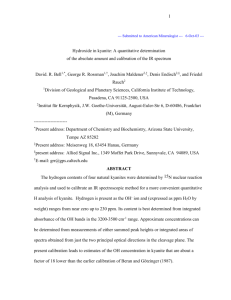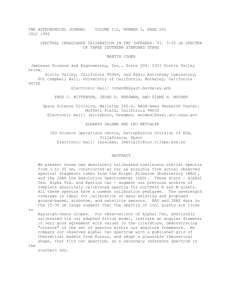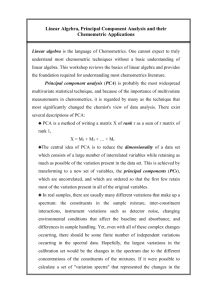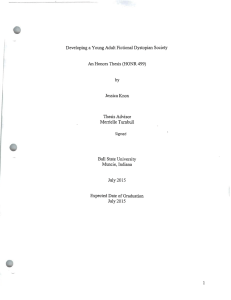Hydroxide in kyanite: A quantitative determination
advertisement
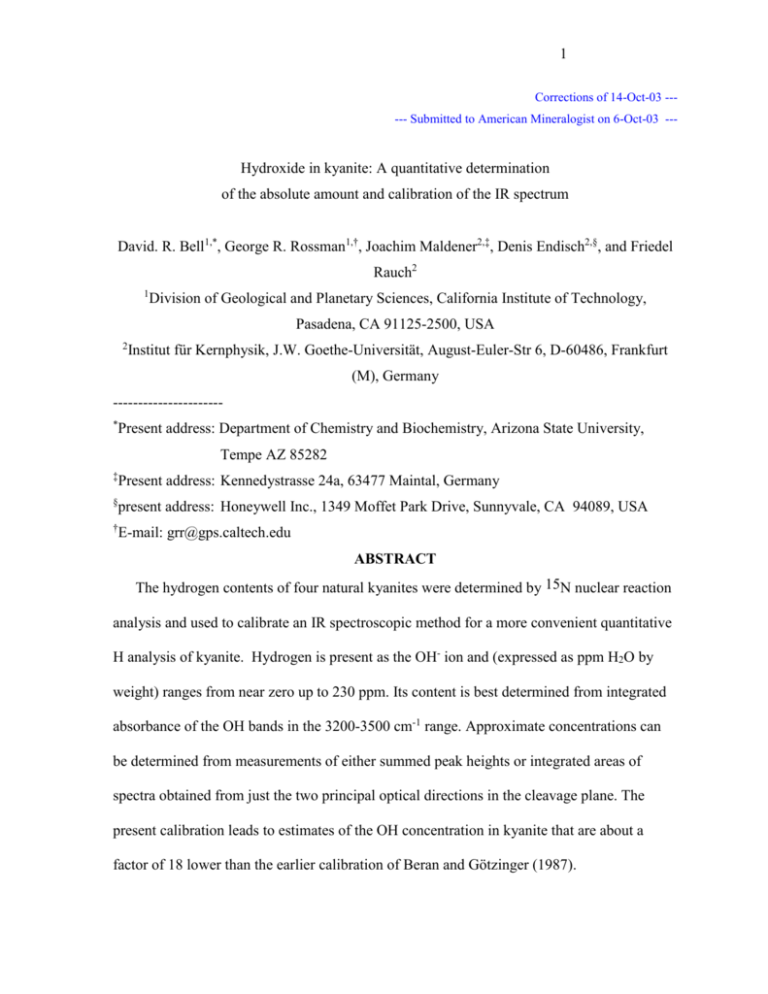
1 Corrections of 14-Oct-03 ----- Submitted to American Mineralogist on 6-Oct-03 --- Hydroxide in kyanite: A quantitative determination of the absolute amount and calibration of the IR spectrum David. R. Bell1,*, George R. Rossman1,†, Joachim Maldener2,‡, Denis Endisch2,§, and Friedel Rauch2 1 Division of Geological and Planetary Sciences, California Institute of Technology, Pasadena, CA 91125-2500, USA 2 Institut für Kernphysik, J.W. Goethe-Universität, August-Euler-Str 6, D-60486, Frankfurt (M), Germany ---------------------* Present address: Department of Chemistry and Biochemistry, Arizona State University, Tempe AZ 85282 ‡ Present address: Kennedystrasse 24a, 63477 Maintal, Germany § present address: Honeywell Inc., 1349 Moffet Park Drive, Sunnyvale, CA 94089, USA † E-mail: grr@gps.caltech.edu ABSTRACT The hydrogen contents of four natural kyanites were determined by 15N nuclear reaction analysis and used to calibrate an IR spectroscopic method for a more convenient quantitative H analysis of kyanite. Hydrogen is present as the OH- ion and (expressed as ppm H2O by weight) ranges from near zero up to 230 ppm. Its content is best determined from integrated absorbance of the OH bands in the 3200-3500 cm-1 range. Approximate concentrations can be determined from measurements of either summed peak heights or integrated areas of spectra obtained from just the two principal optical directions in the cleavage plane. The present calibration leads to estimates of the OH concentration in kyanite that are about a factor of 18 lower than the earlier calibration of Beran and Götzinger (1987). 2 INTRODUCTION Initial infrared studies of kyanite determined that OH commonly occurs in this mineral (Beran 1970, 1971; Wilkins and Sabine 1973; Beran et al. 1983; Beran et al. 1989). OH is likewise identified in the infrared spectra of the other aluminosilicate polymorphs, andalusite and sillimanite. (Beran and Zemann 1969; Wilkins and Sabine 1973; Beran et al. 1983; Beran et al. 1989, Bell and Rossman, 1992). The aluminosilicates are widespread components of crustal rocks and an improved knowledge of their hydrous components may lead to a further understanding of metamorphic conditions and processes. Of particular interest is the observation that OH is found in generally greater abundance in samples from mantle eclogites (Beran and Götzinger 1987; Rossman and Smyth, 1990; Beran et al. 1993). This observation supports speculation that kyanite may transport some water in subducted crust and, after potential transformation to AlSiO3OH, may transport some water into the deep Earth (Bell and Rossman, 1992; Schmidt et al. 1998). Wilkins and Sabine used electrolytic water analysis and found between 90 and 600 ppm H2O in kyanites from a variety of localities. From the infrared spectra they presented, we now recognize that most of the major features in many of the spectra are from layer silicates or liquid water. However, a common feature in many of their infrared spectra and those of all other studies are a series of relatively sharp OH absorption bands in the infrared spectrum in the 3200 to 3500 cm-1 region that are now attributed to bound OH in the kyanite structure. IR spectroscopy is currently the most sensitive technique for quantifying OH in most minerals but requires an independent calibration for each phase. The first attempt to provide a mineral specific calibration of the kyanite spectrum was presented (Beran and Götzinger 3 1987) using a moisture analyzer (thermal release) to determine the water content. An alternative approximate approach to calibration is a relationship between absorption frequency and molar absorptivity, based on data for OH groups in stoichiometrically hydrous minerals as most recently revised by Libowitzky and Rossman (1997). While mineralspecific calibrations for different minerals containing OH with weak hydrogen bonds can vary up to a factor of three from the general, approximate trend (Bell et al. 2003), the kyanite calibration of Beran and Götzinger (1987) deviates by a factor of 15 in the direction of high water content. Such a large deviation is exceptional. Based on our own experience with the tendency of thermal release experiments to overestimate the bound water content of the nominally anhydrous minerals, we elected to analyze the H concentration of four spectroscopically well-characterized kyanite crystals by 15N NRA, which yields absolute H concentration values and thus, water concentration values. We use the results to provide a new calibration of the integrated IR absorbance and peak heights of the OH bands in kyanite. ANALYTICAL METHODS Samples The study forms part of an ongoing effort to refine the quantitative analysis of trace quantities of H in minerals, in which a number of different minerals have been analyzed to date (Rossman et al. 1988, Hammer et al. 1996; Maldener et al. 2001, Bell et al. 2003). The samples were chosen to span a range of IR absorbance and most importantly, to provide a surface that minimized cracks or imperfections that might host contaminant H. Sample origins and compositions [to be determined] are given in Table 2. 4 FSM-15 is a uniformly medium blue 5.0 x 4.1 mm crystal. LTL-3 is a uniformly light blue 3.2 x 2.5 mm oval slab with only a small number of inclusions. H-85943 is a nearcolorless 6.8 x 3.5 mm rectangular slab with a 0.3 mm blue streak running down the center of the slab. It is nearly free of internal inclusions. H-105650 is a uniformly medium blue 5.6 x 2.7 mm rectangular slab with a few tubular inclusions running the width of the sample. Samples were initially prepared by exposing a cleavage surface, followed by grinding and polishing down to a final polish with 1 m alumina. To obtain spectra with the electric vector perpendicular to the cleavage plate, two cuts with a 50 m wire saw were made on an end of each sample. The cut surface was then polished with diamond Mylar® film down to a 1 m final polish. Only sample H105650 had a tendency to cleave during this stage of preparation. Compositions were determined by wavelength-dispersive X-ray analysis using the JEOL733 electron microprobe at Caltech. Accelerating voltage was 15 kV, but beam currents and counting times were varied, depending on the concentration of the elements of interest. Natural and synthetic mineral standards were employed, and the K-ratios were converted to concentrations with the z) correction scheme of Armstrong (1988). 15N Nuclear Reaction Analyses The NRA measurements were performed using the 15N technique (Lanford, 1978), that is based on the nuclear reaction 1H(15N,)12C. They were conducted at the accelerator laboratory of the Institut für Kernphysik, Frankfurt am Main, with a 2 mm 15N2+ beam delivered by the 7 MV Van de Graaff accelerator. The apparatus used has been specially designed for the analysis of low H concentrations in mineral samples. A detailed description of the experimental design can be found in Endisch et al. (1994) and a discussion of the analytical method and a typical NRA profile has been presented for olivine (Bell et al., 5 2003). Salient aspects of the kyanite analyses include a Pb-shielded bismuth germanate (BGO) scintillation detector with anti-coincidence counting system for reduction of cosmicray background, with the samples placed in a high-vacuum chamber at 2 x 10-9 torr. Despite the extensive measures employed to minimize background H, a finite background or blank level may contribute to the amount of H measured. Due to the evolving methods of background reduction, the absolute background contribution to each analysis may vary somewhat. In the most recent set of procedures, analysis of anhydrous silica glass and a silicon wafer place this estimate at 2 2 ppm H2O. IR Spectroscopy Infrared spectra were determined at Caltech on either a Nicolet 60SX or a Nicolet Magna 860 spectrometer fitted with an air-spaced Glan-Foucault type LiIO3 prism polarizer producing linearly polarized IR radiation of high polarization purity and operating at 2 cm-1 resolution. We used the sample preparation and spectrometric techniques for biaxial minerals described by Miller et al. [1987] and Bell et al. [2003]. All samples were independently run at least twice in the and polarizations to confirm that reproducible results could be obtained. The background correction is often not well constrained and is a potential source of inaccuracy in the IR analysis of all minerals, particularly those with low H contents. In the case of kyanite, the subtraction of a dehydrated mineral spectrum was not necessary because of the simple, flat background to the OH absorptions of this mineral. Band intensities were determined through a variety of methods as discussed in the respective sections. 6 RESULTS NRA analysis High H contents occur at the sample surface, with counts decreasing as the comparatively H-poor interior is penetrated with higher energy ions. Figure 1 shows a representative total profile for the FSM-15 sample and the interior profiles for the other samples converted to their depth equivalent. The concentration profile levels off at depths of a few hundred nm to a value that represents the intrinsic H content of the kyanite. H concentrations determined from the NRA measurements, expressed as ppm H2O by weight, are reported in Table 1. The uncertainties reported are based on counting statistics and also include uncertainties in stopping cross section of the 15N ions and in gamma ray detection efficiency. The cause of the deviation from a constant H content that is obvious in the expanded plot is the main source of uncertainty in the water content of the kyanite. Whether this arises from inhomogenity in the samples themselves, or from factors associated with the analysis, is unknown. This ‘noise’ in the kyanite determinations is much greater than the variation observed in the olivine analyses of Bell et al. (2003). IR spectroscopy Kyanite IR spectra are shown in Figures 2a-c and are similar to previously published spectra. The dominant absorption in all three polarizations is between 3650 and 3450 cm-1. Intensity data derived from the spectra are reported in Table 1. Both integrated areas and summed peak heights were measured in an attempt to determine the optimal way to determine the water content of kyanite. Additional details on the exact methods are provided in the sections below on the different calibration methods. 7 CALIBRATION OF THE IR SPECTRUM Our first approach for determining the OH concentration from the IR spectrum in the OH region in kyanite is to determine the integrated area under the OH absorption bands and to calibrate this area with the NRA results. This method previously worked well with garnets and olivines. Ideally, we would obtain spectra along the three principal axes of the indicatrix (the three principal extinction directions corresponding to the X, Y and Z axes). In the case of kyanite, the triclinic crystal system renders such measurements inconvenient. Instead, we measured the two extinction directions occurring in the plane of the (100) cleavage. These are oriented close to the Y and Z directions. The third direction measured was a vibration direction perpendicular to the cleavage plane that is almost coincident with the X direction. As Libowitzky and Rossman (1996) have shown, the total water content can be determined by spectral measurement in any three orthogonal extinction directions. After the appropriate baselines are subtracted, the integrated areas of the three individual absorption spectra are normalized to a unit thickness and added together to obtain a ‘total’ integral absorbance, Abstot, v2 v2 v2 Abstot = 1/t1 Abs1d + 1/t2 Abs2d + 1/t3 v1 v1 v1 Abs3d (1) where the thicknesses of the slices in the three directions are given by t1, t2 and t3, and Abs1 is the integrated absorbance in the E||1st direction, etc. For the purposes of our work, the unit of thickness to which data are normalized is 1.00 cm and the region of integration is usually from 3700 to 3050 cm-1. This includes the three sharp bands in the 3340 to 3480 cm-1 region and the two overlapping bands near 3270 cm-1 and variable bands in the 3600 cm-1 region. 8 The baseline correction is taken as a straight line between the two ends of the integration region. The results are shown in Figure 3. Our second method is similar to the first, but uses only the two extinction directions in the cleavage plane. This method is more convenient as a practical matter due to the ease of preparation of kyanite cleavage slabs. The results are also shown on Figure 3. Our third approach for determining the OH concentration from the IR spectrum is to determine the summed peak heights of the five bands in the 3200 – 3500 cm-1 in the beta spectrum. The peak height of each band is determined from the same straight baseline used for the integrations. Because the bands near 3280 cm-1 are overlapped and differ from spectrum to spectrum in the amount of overlap, we compared both visual estimates of the two band heights and heights determined through the PeakFit v4.05 (SPSS Inc.) program. The results of these two approaches barely differed. This approach also has the advantage that it can also be used with easily prepared cleavage fragments. Furthermore, because the spectrum consists of comparatively sharp bands on a nearly flat background, errors due uncertainty in the baseline are much less important than is the case for methods based on integration of band areas. Figure 4 shows the results. Our fourth method was to determine just the peak height of the band at 3387 cm-1 in the beta spectrum. The result is shown in Figure 5 along with a point that represents Beran and Götzinger’s (1987) calibration determined as discussed in a following section. The third and fourth approaches work in the case of kyanite because the spectrum does not show large variations from sample to sample, unlike the cases of garnet and olivine. EVALUATION OF THE RESULTS AND THE IR CALIBRATION 9 Our results are reported in Table 1. Using our first method of integrating three extinction directions (Fig. 3), we find significant deviation from a straight-line calibration between the infrared intensities and the water content determined with the NRA method if we include all four samples. However, if the LTL-3 data are eliminated from consideration, an excellent linear correlation exists between the integrated infrared area and the NRA water contents. Likewise, the methods based on integration of two directions and on the sum of peak heights also deviate greatly from straight lines if the LTL-3 data are included, but exhibit a trend much closer to linear if this datum is excluded. The decision to exclude this datum is motivated by two facts. First, the kyanite spectra are similar in band positions, halfwidths, and relative heights. Thus we conclude that the spectra are coming from essentially the same chemical species. Second, in view of the spectral similarity, we expect that the IR intensities would be correlated with the absolute OH concentrations as exhibited by the other three samples. The reason for the anomalous result is not apparent, but could represent analytical error or an unrecognized heterogeneity in OH content near the surface of the sample. Thus, we elect to disregard the LTL-3 datum in order to proceed with usable results. A linear regression of the data in Fig. 3 gives a slope of 0.149 0.012 and intercept of 2.74 [] ppm H2O. When constrained to pass through the origin, the regression leads to the following calibration equation. H2O (in ppm by weight) = 0.147 [ 0.002] × Integrated-Abstot. (2) An alternative way to express this calibration is through equation (3): Integrated-Abstot = I × thickness (cm) × cH2O (3) where I is the integral molar absorption coefficient and cH2O is in units of molesH2O/liter. In the case of kyanite, our calibration with three polarizations leads to I = 32900 L×mol-1×cm-2. 10 This is between the corresponding values for olivine (28450) and clinopyroxene (38300) (Bell et al. 2003; Bell et al. 1995). Because kyanite varies so little in composition from the ideal endmember, cH2O can be determined from this calibration, within the uncertainty of our measurements, without concern for a density correction. While it has been recognized for other systems that the intensity of OH bands (as expressed through the Beer’s Law calibration constant, tends to decrease with increasing wavenumber (Libowitzky and Rossman, 1997), we do not have enough data to determine if this is an important factor for kyanite, particularly with respect to comparison of mantle and crustal samples that have differences in the proportions of the different OH bands. DISCUSSION Comparison to a previous calibration The current calibration, even with its uncertainty, differs significantly from the calibration of Beran and Götzinger (1987) (B&G). The methods used for the calibrations are different; the previous calibration used unpolarized infrared light on a cleavage slab of kyanite from Pizzo Forno, Switzerland, and an elemental analyzer for the water determination (thermal release). We can compare our results to the previous calibration in the following way. The spectrum presented for B&G’s Pizzo Forno sample (in %T) was digitized and converted to absorbance. A sample of kyanite (CIT 3750) from the same locality was run in our laboratory, both unpolarized and polarized. The ratio of the intensities of the bands in the unpolarized spectra of the two samples at 3380 cm-1 was used as a factor to estimate what would be the intensity of the polarized spectrum of the B&G sample with the knowledge of the intensity of the polarized spectrum of our sample. The 11 estimate is that the 3380 cm-1 band of the B&G sample would have an absorbance of 0.24. This value is plotted in the lower right of Figure 5 and deviates far from the calibration trend of this study. Whereas B&G found 230 ppm H2O ( 12% relative uncertainty from the B&G water determination), our calibration would bring the H2O content of their sample to about 13 ppm and the range of H2O contents in the kyanites they studied from <0.005-0.180 wt.% to <0.0003 – 0.010 wt%. There are two possible reasons for the difference between the two calibrations. It is now recognized that the sample of B&G contained hydrous contaminants such as kaolinite mica and chlorite (Beran, pers comm.) that would decompose during the hydrogen determination and become part of the analysis. Furthermore, the propensity of kyanite to develop incipient cleaves at the edges of the grains contributes to the analytical difficulties. These cleavages can entrap water that will also be released in the course of the analysis. Previously, Beran et al. (1989) noted that the majority of the OH content of sillimanite was held in a form that was easily driven off at less than 700C, and that did not contribute to the sharp OH bands in this phase. This water was believed to reside in incipient cleavages, and surface damage at the edge of the easily cleaved mineral. Kyanite is likewise subject to cleavage, and often displays internal cleavages manifested by interference colors, and incipient cleavages at the edge of the crystals. These damage sites may well be coated with water that would be released in a thermal release experiment. In contrast, because the NRA method places the sample under ultrahigh vacuum and does not analyze the edge region of the sample where the cleavages occur, it should be nearly immune to these effects and should produce lower, but more accurate, H-contents. 12 Other forms of H in kyanite The spectral features of layer-silicates have been identified in the 3700 – 3450 cm-1 region by Beran and Götzinger (1987). They become more significant in turbid regions of samples and are most prominent in crustal metamorphic samples. Samples for our analysis were chosen to be free of any visible clay or other alteration products. However, the infrared spectra used in this calibration did include bands indicative of the presence of small amounts of clays. Consequently we included all OH bands in the integration. Because the nuclear reaction analysis interacts with only a small fraction of the entire volume of the sample, there is the possibility of a significant error in the calibration if the hydrous components are not homogeneously distributed. The amount of contribution of clays and related phases to the Abstot is typically on the order of 10% or less. The contribution to the total integrated absorbance from the bands assigned to layer silicates is small in the case of high OH-content samples (e.g. 2.3% for FSM-15) but becomes more significant for the lower OH-content samples. Implications for crustal and mantle water contents Kyanite is a minor phase overall in the crust and the mantle and the calibration presented here shows that it does not contribute significantly to the global hydrogen reservoir in the earth. Based on the natural minerals analyzed to date, it is unlikely that kyanite transports significant quantities of water to the mantle during subduction. However, as Schmidt et al. (1998) speculate, after potential transformation to AlSiO3OH, it may transport some water into the deep Earth. Perhaps more significantly, this calibration lays a quantitative foundation for developing a better understanding of the role of water in 13 metamorphic processes in the lithosphere, where kyanite and other aluminosilicates are widespread in metamorphic rocks. ACKNOWLEDGEMENTS We thank Carl Francis for providing samples from the Harvard Mineral Collection, John Gurney (Capetown, SA) for sample FSM-15, and De Beers Consolidated Mines for sample LTL-3. This study was conducted with support from the Deutsche Forschungsgemeinschaft (grant Ra303/14) to FR and NSF grants EAR-8816006, EAR-9104059, EAR-9804871 and EAR-0125767 to GRR. DRB acknowledges support from DOE Office of Basic Energy Sciences grant DE-FG02-93ER14400 and the Geophysical Laboratory, Carnegie Institution of Washington. The manuscript was improved by critical comments from Anton Beran (Vienna). REFERENCES CITED Armstrong, J. T. (1998) Quantitative analysis of silicate and oxide materials: comparison of Monte Carlo, ZAF, and Φ(ρz) procedures. Microbeam Analysis (San Francisco), 23rd, 239-46. Bell, D.R., Ihinger, P.D., and Rossman, G.R. (1995) Quantitative analysis of trace OH in garnet and pyroxenes, American Mineralogist, 80, 465-474. Bell D.R., and Rossman, G.R. (1992) Water in the earth’s mantle: the role of nominally anhydrous minerals, Science 255, 1391-1397. Bell, D.R., Rossman, G.R., Maldener, J., Endisch, D., and Rauch, F. (2003) Hydroxide in olivine: A quantitative determination of the absolute amount and calibration of the IR 14 spectrum. Journal of Geophysical Research, 108(B2), 2105, doi:10.1029/2001JB000679, 2003. Bell, D.R., Rossman, G.R., and Moore, R.O., (2003) Abundance and partitioning of OH in a high-pressure magmatic system: megacrysts from the Monastery kimberlite, South Africa. Journal of Petrology, in press. Beran, A., Zemann, J. (1969) Messung des Ultrarot-Pleochroismus von Mineralen VIII. Der Pleochroismus der OH-Streckfrequenz in Andalusit. Tschermaks Mineralogische und Petrographische Mitteilungen 13, 285-292. Beran, A. (1970) Ultrarotspektroskopischer Nachweis von OH-Gruppen in den Mineralen der Al2SiO5-Modifikationen. Anzeiger - Österreichische Akademie der Wissenschaften, Mathematisch-naturwissenschaftliche Klasse, 1970, 184-185. Beran, A. (1971) Messung des Ultrarot-Pleochroismus von Mineralen XII. Disthen. Tschermaks Mineralogische und Petrographische Mitteilungen 16, 129-135. Beran, A., Hafner, S., and Zemann, J. (1983) Untersuchungen über den Einbau von Hydroxilgruppen im Edelstein-Sillimanit. Neues Jahrbuch für Mineralogie, Monatshefte, 1983, 219-226. Beran, A., and Götzinger, M.A. (1987) The quantitative IR spectroscopic determination of structural OH groups in kyanites. Mineralogy and Petrology 36, 41-49. Beran, A., Rossman, G.R., and Grew, E.S. (1989) The hydrous component of sillimanite. American Mineralogist, 74, 812-817. Beran, A., Langer, K., and Andrut, M. (1993) Single crystal infrared spectra in the range of hydroxyl fundamentals of paragenetic garnet, omphacite, and kyanite in an eclogitic mantle xenolith. Mineralogy and Petrology, 48, 257-68. 15 Endisch, D., Sturm, H., and Rauch, F., Nuclear reaction analysis of hydrogen at levels below 10 at. ppm., Nuclear Instruments and Methods in Physics Research B84,380-392, 1994. Hammer, V.M.F., Beran, A., Endisch, D., and Rauch F. (1996) OH concentrations in natural titanates determined by FTIR spectroscopy and nuclear reaction analysis. European Journal of Mineralogy, 8, 281-288. Lanford, W.A. (1978) 15N Hydrogen profiling: scientific applications. Nuclear Instruments and Methods in Physics Research B, 149, 1-8. Libowitzky, E., and Rossman, G.R. (1996) Principles of quantitative absorbance measurements in anisotropic crystals. Physics and Chemistry of Minerals, 23, 319-327. Libowitzky, E., and Rossman, G.R. (1977) An IR absorption calibration for water in minerals. American Mineralogist, 82, 1111-1115. Maldener, J., Rauch F., Gavranic, M., and Beran, A. (2001) OH absorption coefficients of rutile and cassiterite deduced from nuclear reaction analysis and FTIR spectroscopy, Mineralogy and Petrology, 71, 21-29. Miller, G.H., Rossman, G.R., and Harlow, G.E. (1987) The natural occurrence of hydroxide in olivine. Physics and Chemistry of Minerals, 14, 461-472. Rossman, G.R., Rauch, F., Livi, R., Tombrello, T.A., Shi, C.R., and Zhou Z.Y. (1988) Nuclear analysis of hydrogen in almandine, pyrope, and spessartite garnets. Neues Jahrbuch für Mineralogie, Monatshefte 1988, 172-178. Rossman, G.R. and Smyth, J.R. (1990) Hydroxyl contents of accessory minerals in mantle eclogites and related rocks. American Mineralogist, 75, 765-780. Rossman, G.R. (1996) Studies of OH in nominally anhydrous minerals. Physics and Chemistry of Minerals, 23, 299-304. 16 Schmidt, M.W., Finger, L.W., Angel, R.J., and Dinnebier, R.E. (1998) Synthesis, crystal structure, and phase relations of AlSiO3OH, a high-pressure hydrous phase. American Mineralogist 83, 881-888. Wilkins, R.W.T. and Sabine, W. (1973) Water content of some nominally anhydrous silicates. American Mineralogist, 58, 508-516. FIGURE CAPTIONS Figure 1. a) NRA profile for kyanite FSM-15. Representative error bars based on counting statistics and nuclear corrections are illustrated for some points. The profile shows the high water content at the surface (left) and represents about 2000 nm depth into the sample on the right. b) Expanded graph of the NRA profile of the interior portion of the sample. c) NRA profiles of LTL-3 (squares), H85943 (triangles), and H105650 (circles). A horizontal line indicates the average interior water content of each sample. Figure 2. Infrared spectra of kyanite standards scaled to 1.0 mm thickness. The spectra are displaced vertically for clarity. a) Spectra polarized in the X direction (alpha spectrum). b) Spectra polarized in the Y direction (beta spectrum). c) Spectra polarized in the Z direction (gamma direction). Figure 3. Correlation of the infrared integrated intensities vs. water content determined by NRA for kyanite. The graph compares integrations of all three extinction directions with the two extinction directions (’ and ’) in the cleavage plate. The line through the 3polarization data is a linear regression that does not include the datum for LTL-3. The dotted line through the 2-polarization data is not based on a regression; it is only intended to suggest an approximate working curve for 2-polarization data. 17 Figure 4. Relationship between the summed infrared band heights in the beta spectrum on the cleavage plane vs. the water content determined by NRA. Figure 5. Comparison of our calibration to the calibration of Beran and Götzinger (1987) as expressed through the height of the 3380 cm-1 band.
